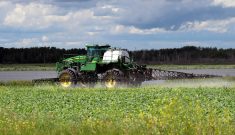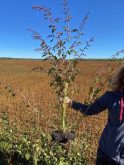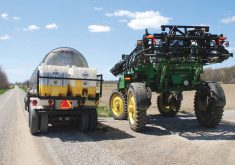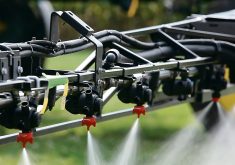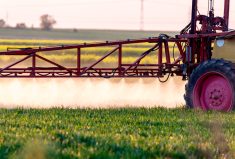Researchers from the University of Quebec say farmers might want to use glyphosate more sparingly — and for reasons beyond herbicide resistant weeds.
Why it matters: Glyphosate may be comparatively benign, but overuse can still raise agronomic and environmental concerns.
Presenting at the Innovative Farmers Association of Ontario’s annual conference, Marc Lucotte, research chair with the University of Quebec’s department of earth and atmospheric sciences, described glyphosate as a valuable and useful herbicide.
Glyphosate is commonly used by farmers across Canada, says Lucotte, which explains why trace amounts of the herbicide, however insignificant, are frequently detected in surface water. He adds while glyphosate has a low toxicity, elevated levels can have an impact on aquatic ecosystems.
This also applies to AMPA — the compound left after glyphosate goes through the first part of its natural breakdown process. (AMPA subsequently breaks down into inorganic phosphorus and other compounds.)
Ontario and Quebec sit at a general rate of 20 and 10 micrograms per litre of water — well below what is considered “acute aquatic toxicity,” though effects are still observable, he says.

“In Quebec and Ontario…we are starting to see the effects on plankton,” says Lucotte. His field research also indicated that glyphosate loss happens regardless of physical barriers.
“A buffer strip would need to be at least 15 to 20 metres wide to have any effect,” he says.
Kari Dunfield, professor in the University of Guelph’s School of Environmental Sciences, and Canada Research Chair in environmental microbiology of agro-ecosystems, says research shows glyphosate can cause shifts in microbial communities, including those of phytoplankton.
She says this appears to be what some of Lucotte’s research indicates.
However, shifting communities does not mean dying communities since some organisms can actually work with the glyphosate molecule.
Read Also

Senft to step down as CEO of Seeds Canada
Barry Senft, the founding CEO of the five-year-old Seeds Canada organization is stepping down as of January 2026.
She adds the ability of glyphosate to resist breakdown by binding to minerals in the soil means soil loss could be another source of buildup. But so long as the glyphosate molecule remains bound, it is also not bioavailable.
“I think there’s a distinction between a bioavailable form and a not bioavailable form … where it’s not having an effect on organisms,” says Dunfield. “Is it present or is it interacting? Those are two different things.
“Even if AMPA hangs around a bit longer it still degrades.”
Impact on crops and soil
In 2014, Lucotte and his colleagues conducted a soil analysis project comparing Quebec soybean production systems (organic, IP, and Roundup-Ready). Traces were found in each system.
“Organic had the lowest, but it was not zero,” he says. There was little difference between the other two classifications.
The researchers repeated the study in 2019 using the same test locations. Lucotte says their organic-system samples still had detectable levels of glyphosate, with AMPA levels actually rising in about half of the cases overall.
The compounds were also found at depths of 20 to 40 centimetres, and in greater abundance in heavier clay soils.
Initially Lucotte says they thought no-till and cover-crop systems would help degrade glyphosate, but it just stays in the soil, as opposed to full-tillage systems, where it more actively moves from the field to waterways.
Useful as it is in controlling weeds, Lucotte says farmers should consider how glyphosate negatively impacts crops. In Roundup-Ready soybeans, he says, increasing levels of glyphosate correspond with decreasing nodulation and symbiotic nitrogen accumulation, as well as overall plant stress.
Concerns about crops are not new.
As a PhD student in the early 2000s, Dunfield says her research into the effects of glyphosate on Roundup-Ready canola found realistic, field-level applications of glyphosate did bring “some transient effects depending on when you’re sampling.”
But once the next spring came around, everything was back to pre-glyphosate application conditions. Regarding Roundup-Ready soybeans, she says differences in growth and stress levels have also been observed to stem from differences in genetics.
Overall, Dunfield says using any chemical over and over again is likely to have some measurable effects over time.
But she stresses the importance of considering whether realistic applications of glyphosate — and the associated buildup of glyphosate and AMPA at those levels — poses a serious threat.
“You can see impacts if you’re looking for them,” she says. “I think we also need to put it into perspective with other agricultural practices, like what is tillage doing to these organisms?”
More strategic use never a bad idea
Regardless of research nuances, both Lucotte and Dunfield say considering more strategic uses for glyphosate, or any input, is not a bad thing.
“We didn’t realize (when we were studying canola) people would be applying it repeatedly as much as they are,” says Dunfield. “It’s important to use chemicals as needed, maybe treating them like antibiotics. Save it for when you need it.”
Looking to other, and potentially harsher, herbicide alternatives is not the only solution for reducing glyphosate use. For his part, Lucotte encourages farmers to consider weed-supressing cover crops.
“I’m not against chemistry …. Let’s try to use glyphosate in a safer way and in smaller doses, and eventually get away from our dependence on this chemical.”





